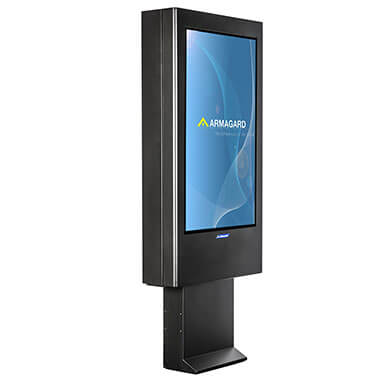Outdoor digital signage has many uses and advantages. For advertising an outdoor screen will receive far more views than a comparable indoor display, while for providing information, an outdoor screen can reach customers and service users before they enter a building, providing crucial information. Businesses, public buildings and educational facilities are increasingly turning to outdoor digital signage as a form of communication, but using screens in outdoor locations requires proper forethought and planning.

Outdoor screens face many challenges that indoor screens don’t, such as overcoming the problems caused by weather, extreme temperatures and risk of vandalism, not to mention overcoming the problems caused by installation in outdoor areas.
Objectives—the first step to installing outdoor digital signage is to establish clear objectives for what you want the screen to achieve. Whether it’s advertising, increasing brand awareness or providing important information, having clear goals can affect different aspects of the project, from size of screen to the location.
Location—finding the right location for the screen is crucial. Visibility is one of the most important aspects for outdoor digital signage and the position and location of the screen should be in the most visible location possible. By taking into account the approach of the intended audience, you should place the screen as near to eye-level as possible. Screens placed too high, such as suspended from ceilings, are all too easily unnoticed, but if you have to mount a screen high up, it should be tilted towards the eyes of the intended audience.
Screen type—because visibility is important, sing the largest screen size possible can help ensure maximum exposure. Other aspects to the type of screen used affect outdoor digital signage too; screens used outdoors need a much higher brightness level than indoor screens, due to having to compete with sunlight.
Protection—outdoor digital signage needs protection from the weather, temperature and need to be physically robust to deal with accidental impacts and vandalism. Often this causes the most challenging aspect of installing an outdoor digital signage display, although outdoor LCD enclosures offer simple but comprehensive outdoor protection.
Installation—digital signage requires power and, if on a network, access to a server too. Installing screens outdoors requires feeding wires through buildings and finding access points to connect. With individual screens, where content is uploaded directly to the screen, these problems are reduced.
Content—once installed, an outdoor digital signage screen is going to need something to display. Outdoor content also differs to the type of content used indoors. Dwell times and the distance and outdoor screen differ, with the average outdoor digital signage display viewed for less time and from farther away. Content needs, therefore, to be bold, prominent and to the point.
Comments are closed.